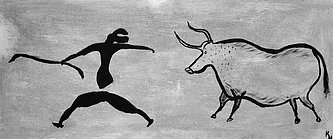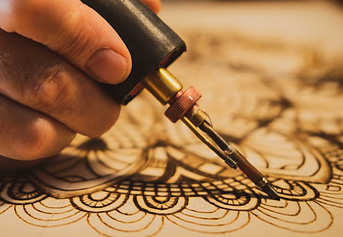Wood Burning Pyrography
 Another woodworking craft I would like to introduce is wood burning using a unique technique called pyrography. The definition of pyrography defined by Google, Bing and Yahoo search comes up as the art or technique of decorating wood or leather by burning a design on the surface with a heated metallic point. But let’s dig a little deeper, shall we. When I say a little deeper, I mean, deeper in Time, itself. Back to the prehistoric era. Yep, as in when the woolly mammoth and the saber tooth tigers roamed the earth. Wood burning was not even thought of back then as we now know. It was more like burning wood for survival!
Another woodworking craft I would like to introduce is wood burning using a unique technique called pyrography. The definition of pyrography defined by Google, Bing and Yahoo search comes up as the art or technique of decorating wood or leather by burning a design on the surface with a heated metallic point. But let’s dig a little deeper, shall we. When I say a little deeper, I mean, deeper in Time, itself. Back to the prehistoric era. Yep, as in when the woolly mammoth and the saber tooth tigers roamed the earth. Wood burning was not even thought of back then as we now know. It was more like burning wood for survival!
When Did Pyrography Start?
According to history, it is stated many times over, pyrography was first used and discovered by early humans within prehistoric times during the early Stone Age or Lower Paleolithic. But pyrography was crude at its best. There are paintings on cave walls, on old bones, pottery and so forth but over time ash, animal blood, berries, tree sap, and powder from different colored crushed rocks. The paste was then spited over a fire to melt into a paste then animal fat was added. After cooking for a while, the paste would have a lax structure.
So, picture this, prehistoric homo erectus, 3.3 million years ago, somehow discovered fire. Reports of how fire was discovered either as lightning striking a tree or perhaps striking two flints together but who knows how homo erectus really discovered fire. The homo erectus used fire as a gathering place for safety, made tools, pottery, and cooked food. The bigger the fire meant more protection from predators during the night and provided warmth as well.
discovered fire. The homo erectus used fire as a gathering place for safety, made tools, pottery, and cooked food. The bigger the fire meant more protection from predators during the night and provided warmth as well.
From smoldering sticks to iron to metal rods with fancy handles, Charcoal to Modernized pyrography has come a long way. It is said that pyrography originated from Egypt. But another source dictates two words came from ancient Greek: pur and graphia. Pur means fire and graphia means writing. Putting both words together you get fire writing. Somewhere at the turn of the century another term emerged as pyrogravure.
Pyrography became so popular that yet again another term emerged as pyromania and factories were in high demand to help curve the appetite of the craft, “fire writing”.
Pyrography Becomes Art
Now pyrography is an everyday hobby. People from all around the world make or sell them. It takes time and a lot of pain staking dedication to make them. There are two forms of pyrography. Wood and leather. Wood is the more popular of the two because of the pictures depicted on the wood surface and what the artist has done with the portrait. The artist can control the contrast and highlights and persevere them by sealing the charred strokes. The other method is not so popular unless you are into leather such as wallets, money clips, belts, and belt buckles, etc.
Modern Art of Pyrography
Pyrography is in fact a highly demanded commodity. The artist, once skilled and able to use contrast and highlight, can depict mind-blowing artwork and the portrait can go at a high insane price! Anywhere from $3 to $1000 or more. It all comes down to how long the artist took and what type of wood and supplies used. Not to mention, selling online adding the shipping and handling on top of the cost of the artwork or plaque.
A list of what you need for Pyrography
Pyrography pen (Soldering pen)
Wood (preferably pine and the shape you want)
(“As an Amazon Associate, I earn from qualifying purchases”)
Various wood burning tips or buy a kit from Amazon
Wood burner unit that has various heat settings
Wood burner cord if you want a longer cord then the burner unit supplied
Electric sander or sandpaper: starting at 60 and go up to 200 grits or until desired smoothness is achieved
Safety glasses
PPE: leather gloves, dust mask, latex rubber gloves, ear plugs (dust mask and ear plugs when running the sander)
A wood sealant such as any wood finish oil or mineral oil, walrus oil furniture finish or Waterlox Original Sealer and Finish you can buy from Amazon
When practicing for the first time, or anytime, make sure you wear your dusk mask because of sanding the wood. Wood dust is in the air, and you can breathe in the dust. Wear your ear plugs and safety glasses when sanding. Over time you can start to lose your hearing and anything can enter your eyes. Wear leather gloves when changing out the tips from the pyrography pen. The tips are very hot and will burn and blister your fingers causing 1st or 2nd degree burns. You wouldn’t pick up a hot ember from a fire, would you? Same principle.
 When you get everything ready the first thing you will do is lightly trace a pattern or draw something on the wood surface. Then go back over the portrait by darkening the appropriate lines. Use the appointed tip for outlining the portrait. Take care of how much pressure you apply to the pen. Take note that the pen tips can and will break. Also, watch how the wood burner unit is secured so you don’t knock it over and it falls to the floor. That can be costly if the unit breaks! If you want, buy a long power cord for the pen that connects to the wood burner unit so you can work more freely.
When you get everything ready the first thing you will do is lightly trace a pattern or draw something on the wood surface. Then go back over the portrait by darkening the appropriate lines. Use the appointed tip for outlining the portrait. Take care of how much pressure you apply to the pen. Take note that the pen tips can and will break. Also, watch how the wood burner unit is secured so you don’t knock it over and it falls to the floor. That can be costly if the unit breaks! If you want, buy a long power cord for the pen that connects to the wood burner unit so you can work more freely.
When you are finished with your masterpiece, you may want to seal the wood to preserve with an oil finish.
Conclusion
(Click the Amazon link to shop for a beginners kit)
The links within this article are affiliate links which I receive a small compensation from certain sales of items.
If you are a beginner, there are kits you can buy to get the feel of the pyrography. You can even watch YouTube videos and tutorials. You can also order patterns to trace onto the wood surface to help grasp the concept. As you get more confident with the art, you can get advanced supplies. The more you are working with pyrography will show in the details of the contrast and highlights of the portal and the fine details. These details will stand out and demonstrate your improved skills.
So, who knew, pyrography is said to have originated from the Stone Age as a crude painting on cave walls that help tell a story or warnings to those within their clan. In time, these crude “fire writing” symbols spread all over the world and help shape culture into what we now know in todays times. Now, the wood burning pyrography is considered a hobby of a sort.
If you have any questions or comments, please put them below and I will get back to you.
Thanks, Homer Patrick
